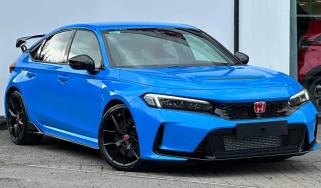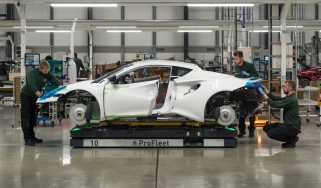Ferrari 360 Modena: history, specs and buying guide
The 360 Modena and Spider are good value right now. If you fancy having one in your life, here’s what you need to know
As an act to follow, the F355 was about as tough as they get. Since its introduction in 1994, it had pretty much transformed not only Ferrari’s fortunes but also its image. When it arrived, the company’s line-up of 348, Testarossa and Mondial was one of its least inspiring in memory. The F355 quickly became the car that every red-blooded male lusted after and would sell in unprecedented numbers, eventually totalling 10,000 in five years.
But Ferrari knew it couldn’t rest on its laurels. Just up the road at Sant’Agata Bolognese, there was a baby Lamborghini in development; Ferrari pride demanded it was fully prepared to meet the challenge.
Revealed in spring 1999 at the Geneva motor show in berlinetta form, the 360 was much more than an evolution of the 355. Gone was the 355’s chiselled delicacy, in its place something bigger and bolder, the Pininfarina curves more generous and voluptuous. Gone, too, were the pop-up lights that could be traced back to the 308 GTB; the 360 placed them under perspex covers, beneath them gaping air intakes for twin water radiators.
> Ferrari F8 Tributo review – still want that McLaren 720S?
Behind the passenger compartment, instead of buttresses running either side of a flat, vented engine cover, here was a glass fastback sweeping down to the tail, affording an uninterrupted view of the red crackle-finish cam covers on the mid-mounted V8 engine. There were familiar Ferrari cues, of course, including the sculpted vents in the flanks that could be traced back to the Dino 206/246, but at the rear were two huge venturi tunnels. It was a fresh look for Ferrari, and one that reflected major changes not only in aerodynamics – the 360 generated up to four times the 355’s downforce – but also in construction.
The 360’s biggest departure was that both its main structure and its outer body panels were entirely aluminium. The chassis used a combination of thicker welded sections in areas where strength was paramount, and thinner bonded sections where strength was less critical, with a view to keeping weight down. The net effect was that although the 360 was a bigger, more refined and noticeably roomier car than the 355 (Ferrari was at pains to point out that there was space behind the seats for a set of golf clubs) and a considerably stiffer and more crash-worthy one, it was only 40kg heavier.
Mechanically, the 360 was very much an evolution of the F355. The capacity of the flat-plane-crank 90-degree V8 had increased from 3.5 to 3.6 litres (hence 360) but it retained the same basic architecture, including the five-valve heads, and variable valve timing. Peak power was up, from 375bhp to 394bhp, and torque climbed slightly, from 268 to 275lb ft, but produced much lower in the rev-range, endowing the 360 with a more muscular feel. The work to achieve this included optimising air-flow into and out of the engine; the addition of eight more throttle trumpets to provide both short and long intake paths, and some clever valving between the plenum chambers and also in the exhaust system to switch between high and low back-pressure.
Response was sharper, too, thanks to new engine management and a drive-by-wire throttle – a first for a Ferrari. This worked particularly well with the optional F1 paddleshift gearbox – also carried over from the 355 – giving quicker but also smoother gearshifts. The 0-62mph claim was now 4.5sec, two tenths quicker than the F355, and the top speed was quoted as 180mph-plus.
As with the 355, the 360 was equipped with ASR traction control but no stability control, and electronically controlled dampers, though further honed to respond even more quickly. Tyre sizes had also been tweaked – the fronts had been reduced in width, from 225/45 to 215/45, while the rears had increased from 265/40 to 275/40. The wheels were more sharply styled starfish-pattern 18in alloys, and behind them were bigger vented disc brakes.
It was in virtually every respect a better car than the 355 – more civilised and commodious when you weren’t tearing up the road, but still with a real Ferrari heart lurking just beneath. Perhaps it wasn’t quite as charismatic – or as downright, timelessly beautiful – as the 355, and that probably explains why in recent times the earlier car has been more highly prized by collectors. The upside is that you can buy the better car for less money, which makes the 360 conspicuously good value right now.
> Ferrari F40 vs 288 GTO - turbocharged icons go head-to-head
Today, £65-70k can get you a really nice example, Berlinetta or Spider. If you can stretch to £85k you’ve pretty much got your pick of low-mileage cars in all the best colour combinations and with the most mouthwatering specs. An F355 in similar condition could be as much as £120,000.
Tony Glynn, sales manager at specialists Foskers, says the growth in values has started to follow the 355 but remains a couple of years behind the earlier car. ‘There’s strong demand for 360s,’ he says, ‘and that’s partly because they’re good value compared with a 355 or a 430.
‘The 355 is undeniably a classic, in many ways the last of the analogue cars, whereas the 360 is perhaps the first of the modern- era Ferraris. It’s a lot easier car to live with and a lot easier to drive than a 355. Maybe not as rewarding as a 355, but it’s just a more modern car without the foibles.’
Interestingly, while a 355 Spider is worth slightly less than the coupé, with the 360 it’s the other way round. And the much rarer manual-gearbox cars command an extra premium. So the most valuable 360 – excluding the Challenge Stradale, which we’ll save for another day – is a manual Spider. ‘A really good manual Spider with, say, 25,000 miles – and ideally red with cream – would be £85k,’ says Tony, ‘whereas a coupé in the same condition would be about £80k, and take off £5000 for an F1.
‘If you’re looking at a 360 as an investment, the manual’s the one to get. If you’re buying it to use for a couple of years, the F1 is great. And a much slicker gearshift than the 355, if not quite as slick as a 430. That’s progress…
‘I always advise people not to buy a car as an investment. Buy the car you like, if you can afford it, look after it, enjoy it, and if at the end you make some money out of it, that’s great! And always buy the best car you can afford. So rather than buy a cheap, leggy F430, buy a low-mileage 360 for the same money.
> Ferrari F430 used buying guide
‘In many ways the 360 is a very affordable Ferrari to run – considerably more so than earlier cars. It’s not an engine-out job to change the cambelts, which is something we always do with the 355, partly so we can see the state of the rear sub-frame. Ferrari learned there, too, because on the 360 it’s aluminium so you don’t get the same rust issues.
‘Don’t imagine that being aluminium there’s no corrosion – on the outer skin you often find bubbling around the front side repeaters, also on the nose just above the bumper, where there are two welds.’
The V8 engine gives few problems. ‘There were issues with the camshaft variators on early cars,’ says Tony, ‘but they should all have been changed under recall – it’s always worth checking the chassis number with a main dealer to be sure all the recalls were done.
‘On the 355, exhaust manifolds cracking has been a recurring issue. We’re starting to see a few with the 360, but nothing like the same number, and the early ones are getting on for 20 years old now.
‘The cabin is solidly made, and on the Spider the hood seems to be holding up well, though they do wear in the area where a buttress would be on a coupé. ‘Suspension balljoints are a weakness – they need changing so often they’re virtually a service item. Budget around £1600 to have all four changed.’
Clutches typically last 20,000 miles on a manual and 15,000 on an F1, more if you’re doing a lot of motorway miles. With the F1, a dealer or specialist with diagnostics can tell you how much clutch life is left. Replacement costs about £1300.
‘Overall, I reckon that if you budget £6000 over three years to run a 360, you won’t be far off,’ says Tony. Sounds good to us. With prices on the up, that should be more than covered. We’ll take a manual coupé in Nero Daytona with carbon seats and Challenge grilles!
What the road testers said at the time
‘Turn the key and the 400bhp V8 lights up with a vicious snarl. Tickle the throttle and the revs flare hungrily before settling back to a high idle that fills the cabin with a rich, complex note… Don’t be fooled by the Modena’s soft lines, its space, refinement and easy-going nature around town; just below the surface is a hard-edged supercar. It’s implicit in the directness of the steering, the bite of the brakes, and especially in the sharpness of the throttle response. It feels much more eager than a 355.
The 360 is a devastating road car. It does everything you’d hope a Ferrari would but with such polish, precision and ease that you don’t have to think twice about unleashing all its performance. There is perhaps no other car yet made that combines so much raw emotion with so much technical finesse.
It’s not a flawless concoction, however. [On track] the 355 is a doddle to slide but I found it hard to get the 360 sideways and, when I did, found it hard to hold on opposite lock. [On the road] the steering doesn’t have the 911’s lucidity, but a 911 won’t keep a hard-driven 360 in sight. You don’t know what throttle response is until you’ve driven the Modena. Line up your corner exit, nail it and revel in the surge and sound as the V8 kicks and its bark mutates into the pure, determined wail of a highly tuned race engine. On the right corner, right at the very exit you can coax the tail into a few degrees of slide with the power (with ASR switched out, of course), but this is an indulgence – you don’t have to drive that way to leave pretty much everything else in your wake.
The 355 had begun to feel a bit overpriced at close to £100,000 but, at just a couple of thousand more, the 360 feels worth every penny. That’s an apposite measure of how much more accomplished the 360 is.’ – 360 Modena v 911 Carrera, evo magazine, June 1999
Ferrari 360 Modena
| Engine | V8, naturally-aspirated, 3586cc |
| Max power | 394bhp @ 8500rpm |
| Max torque | 275lb ft @ 4750rpm |
| Transmission | Six-speed manual gearbox (F1 optional), rear-wheel drive |
| Tyres | 215/45 ZR18 front, 275/40 ZR18 rear |
| Weight (kerb) | 1390kg |
| Power/weight | 292bhp/ton |
| 0-62mph | 4.5sec (claimed) |
| Top speed | 183mph (claimed) |
| Price | £101,243 (1999) |
This was first featured in Enzo issue 1.


